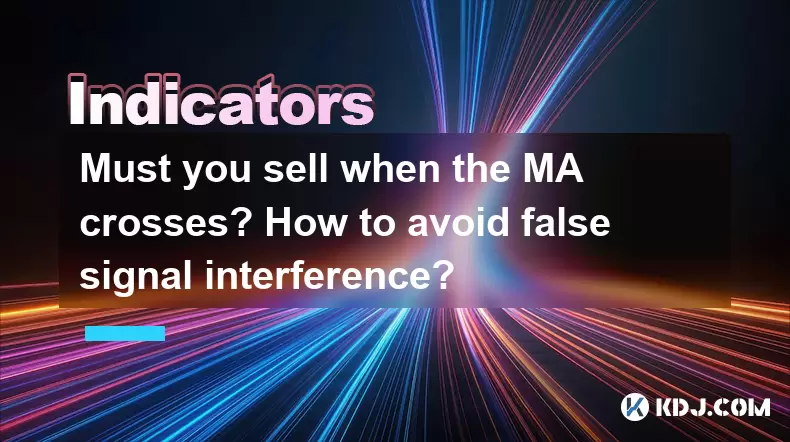-
 bitcoin
bitcoin $109667.069529 USD
-3.03% -
 ethereum
ethereum $3936.685804 USD
-4.07% -
 tether
tether $1.000493 USD
0.01% -
 xrp
xrp $2.771823 USD
-4.74% -
 bnb
bnb $957.805027 USD
-5.34% -
 solana
solana $196.735100 USD
-6.68% -
 usd-coin
usd-coin $0.999727 USD
-0.01% -
 dogecoin
dogecoin $0.227355 USD
-5.12% -
 tron
tron $0.335205 USD
-0.81% -
 cardano
cardano $0.779256 USD
-3.59% -
 ethena-usde
ethena-usde $0.999900 USD
-0.06% -
 hyperliquid
hyperliquid $42.492095 USD
-6.61% -
 chainlink
chainlink $20.501853 USD
-4.34% -
 avalanche
avalanche $28.952606 USD
-11.21% -
 stellar
stellar $0.356038 USD
-3.93%
Must you sell when the MA crosses? How to avoid false signal interference?
Don't sell solely on MA crossovers; consider market context, volume, other indicators, and fundamentals to avoid false signals and make informed decisions.
May 21, 2025 at 10:56 am

In the world of cryptocurrency trading, the moving average (MA) is a popular technical indicator used to identify trends and potential entry or exit points. One common question among traders is whether they must sell when the MA crosses. Additionally, traders often struggle with false signals that can lead to premature or incorrect trading decisions. This article will delve into these topics, providing insights on when to sell based on MA crossovers and strategies to avoid false signal interference.
Understanding MA Crossovers
Moving averages are calculated by taking the average price of a cryptocurrency over a specific period. Common types include the simple moving average (SMA) and the exponential moving average (EMA). A crossover occurs when a shorter-term MA crosses above or below a longer-term MA, signaling potential trend changes.
When a short-term MA crosses above a long-term MA, it's often seen as a bullish signal, suggesting that the price may continue to rise. Conversely, when a short-term MA crosses below a long-term MA, it's considered a bearish signal, indicating that the price may decline. However, the decision to sell based solely on a crossover can be risky due to the potential for false signals.
Factors to Consider Before Selling on a Crossover
While MA crossovers can provide valuable insights, they should not be the sole basis for selling a cryptocurrency. Several factors should be considered before making a trading decision:
Market Context: Evaluate the broader market conditions. Is the entire market experiencing a downtrend, or is the specific cryptocurrency showing signs of weakness?
Volume: Check the trading volume around the crossover. A crossover accompanied by high volume may be more reliable than one with low volume.
Other Indicators: Use additional technical indicators, such as the Relative Strength Index (RSI) or the Moving Average Convergence Divergence (MACD), to confirm the crossover signal.
Fundamental Analysis: Consider the underlying fundamentals of the cryptocurrency. Are there any significant developments or news that could impact its price?
By taking these factors into account, traders can make more informed decisions and reduce the risk of selling prematurely based on a single MA crossover.
Strategies to Avoid False Signal Interference
False signals can lead to unnecessary trades and potential losses. Here are some strategies to help traders avoid false signal interference when using MA crossovers:
Use Multiple Timeframes: Analyze the MA crossover on different timeframes. A crossover that appears on multiple timeframes is generally more reliable.
Combine with Other Indicators: Use other technical indicators to confirm the MA crossover. For instance, if the RSI indicates an overbought condition alongside a bearish crossover, it may strengthen the sell signal.
Set a Confirmation Period: Wait for a certain period after the crossover to confirm the signal. This can help filter out short-term noise and false signals.
Monitor Price Action: Pay close attention to price action around the crossover. If the price quickly reverses after the crossover, it may be a false signal.
Implementing these strategies can help traders filter out false signals and make more accurate trading decisions.
Practical Example of Using MA Crossovers
To illustrate how to use MA crossovers effectively, let's walk through a practical example. Suppose you are trading Bitcoin and using a 50-day SMA and a 200-day SMA.
Identify the Crossover: You notice that the 50-day SMA has crossed below the 200-day SMA, indicating a bearish signal.
Evaluate Market Context: You check the broader market and see that other major cryptocurrencies are also showing signs of a downtrend.
Check Volume: The volume around the crossover is significantly higher than average, suggesting that the signal may be more reliable.
Confirm with Other Indicators: You consult the RSI and see that it's in an overbought condition, further supporting the bearish signal.
Consider Fundamentals: There are no significant positive developments in the Bitcoin ecosystem that could counteract the bearish signal.
Based on this analysis, you decide to sell your Bitcoin position. However, to avoid false signals, you:
Use Multiple Timeframes: You check the daily, 4-hour, and 1-hour charts and see the crossover on all three timeframes.
Set a Confirmation Period: You decide to wait for one more day to see if the bearish trend continues.
Monitor Price Action: You observe the price action closely and see that it continues to decline without significant reversals.
After confirming the bearish signal, you proceed with the sale.
Technical Analysis Tools for MA Crossovers
Several tools and platforms are available to help traders analyze MA crossovers and other technical indicators. Here are some popular options:
TradingView: A comprehensive platform that offers advanced charting tools, including customizable MA indicators and the ability to overlay multiple timeframes.
MetaTrader 4 (MT4): Widely used among forex and cryptocurrency traders, MT4 provides built-in MA indicators and the ability to automate trading strategies.
Coinigy: A cryptocurrency trading platform that offers real-time data and customizable charts, including MA indicators.
CryptoWatch: A platform focused on cryptocurrency markets, offering detailed charts and the ability to set up alerts for MA crossovers.
Using these tools, traders can effectively monitor MA crossovers and implement the strategies discussed earlier to avoid false signals.
Implementing MA Crossovers in Trading Strategies
Incorporating MA crossovers into a trading strategy requires careful planning and execution. Here are some steps to consider:
Define Your MAs: Decide on the specific MAs to use, such as a 50-day and 200-day SMA, or a 12-day and 26-day EMA.
Set Up Alerts: Use trading platforms to set up alerts for when the MAs cross, so you can act quickly on the signal.
Backtest Your Strategy: Before applying the strategy to live trading, backtest it using historical data to assess its effectiveness and identify any potential issues.
Monitor and Adjust: Continuously monitor the performance of your strategy and make adjustments as needed based on market conditions and performance.
By following these steps, traders can effectively integrate MA crossovers into their trading strategies while minimizing the impact of false signals.
Frequently Asked Questions
1. Can MA crossovers be used for both short-term and long-term trading?Yes, MA crossovers can be used for both short-term and long-term trading. For short-term trading, shorter-term MAs such as a 5-day and 20-day SMA can be used to capture quick price movements. For long-term trading, longer-term MAs like a 50-day and 200-day SMA can help identify broader trends.
2. How do I choose the right MA periods for my trading strategy?The choice of MA periods depends on your trading style and the specific cryptocurrency you are trading. Shorter periods (e.g., 5-day and 20-day) are more sensitive to price changes and suitable for short-term trading. Longer periods (e.g., 50-day and 200-day) are less sensitive and better for identifying long-term trends. Experiment with different periods and backtest your strategy to find what works best for you.
3. Are there any specific cryptocurrencies where MA crossovers are more effective?MA crossovers can be effective for a wide range of cryptocurrencies, but they tend to work best with highly liquid assets like Bitcoin and Ethereum. These cryptocurrencies have more reliable price data and higher trading volumes, which can make MA crossovers more accurate.
4. How can I automate MA crossover trading strategies?Many trading platforms, such as MetaTrader 4 and TradingView, allow you to automate MA crossover strategies using custom scripts or built-in tools. You can set up rules for buying and selling based on MA crossovers and let the platform execute trades automatically. However, it's important to monitor automated strategies closely and adjust them as needed based on market conditions.
Disclaimer:info@kdj.com
The information provided is not trading advice. kdj.com does not assume any responsibility for any investments made based on the information provided in this article. Cryptocurrencies are highly volatile and it is highly recommended that you invest with caution after thorough research!
If you believe that the content used on this website infringes your copyright, please contact us immediately (info@kdj.com) and we will delete it promptly.
- XRP Price: October Rally on the Horizon After September Consolidation?
- 2025-09-26 16:25:13
- Bitcoin Price Wobbles: Investors Buy the Dip as Powell's Words Stir Uncertainty
- 2025-09-26 16:25:13
- Kaspa Price, Smart Contracts, and the 2026 Forecast: A New York Minute
- 2025-09-26 16:30:01
- Bitwise, Hyperliquid ETF, and HYPE Token: What's the Deal?
- 2025-09-26 16:45:14
- B HODL, Bitcoin, and Treasury Purchases: The New Institutional Playbook
- 2025-09-26 17:05:15
- Cloudflare, Stablecoins, and AI Agents: A New Era of Automated Finance
- 2025-09-26 16:45:14
Related knowledge

What is a tower bottom candlestick pattern? Does it have a high success rate?
Sep 22,2025 at 07:18am
Tower Bottom Candlestick Pattern Explained1. The tower bottom candlestick pattern is a reversal formation that typically appears at the end of a downt...

What is a black hole pattern in the MACD indicator? Is it a cause for concern?
Sep 21,2025 at 06:54pm
Bitcoin's Role in Decentralized Finance1. Bitcoin remains the cornerstone of decentralized finance, serving as a benchmark for value and security acro...

How can I use the psychological line (PSY) to determine market sentiment?
Sep 17,2025 at 02:19pm
Understanding the Psychological Line (PSY) in Cryptocurrency TradingThe Psychological Line, commonly referred to as PSY, is a momentum oscillator used...

How can I determine if a double top pattern has officially formed?
Sep 21,2025 at 03:18am
Understanding the Structure of a Double Top Pattern1. A double top pattern consists of two distinct peaks that reach approximately the same price leve...

What is the Golden Valley pattern on the moving average? Is it better than the Silver Valley pattern?
Sep 21,2025 at 02:54pm
Understanding the Golden Valley Pattern in Moving Averages1. The Golden Valley pattern is a technical formation observed in cryptocurrency price chart...

What does a death cross of the RSI in the strong zone (above 50) mean?
Sep 17,2025 at 10:54pm
Understanding the Death Cross in RSI Context1. The term 'death cross' is traditionally associated with moving averages, where a short-term average cro...

What is a tower bottom candlestick pattern? Does it have a high success rate?
Sep 22,2025 at 07:18am
Tower Bottom Candlestick Pattern Explained1. The tower bottom candlestick pattern is a reversal formation that typically appears at the end of a downt...

What is a black hole pattern in the MACD indicator? Is it a cause for concern?
Sep 21,2025 at 06:54pm
Bitcoin's Role in Decentralized Finance1. Bitcoin remains the cornerstone of decentralized finance, serving as a benchmark for value and security acro...

How can I use the psychological line (PSY) to determine market sentiment?
Sep 17,2025 at 02:19pm
Understanding the Psychological Line (PSY) in Cryptocurrency TradingThe Psychological Line, commonly referred to as PSY, is a momentum oscillator used...

How can I determine if a double top pattern has officially formed?
Sep 21,2025 at 03:18am
Understanding the Structure of a Double Top Pattern1. A double top pattern consists of two distinct peaks that reach approximately the same price leve...

What is the Golden Valley pattern on the moving average? Is it better than the Silver Valley pattern?
Sep 21,2025 at 02:54pm
Understanding the Golden Valley Pattern in Moving Averages1. The Golden Valley pattern is a technical formation observed in cryptocurrency price chart...

What does a death cross of the RSI in the strong zone (above 50) mean?
Sep 17,2025 at 10:54pm
Understanding the Death Cross in RSI Context1. The term 'death cross' is traditionally associated with moving averages, where a short-term average cro...
See all articles










































































